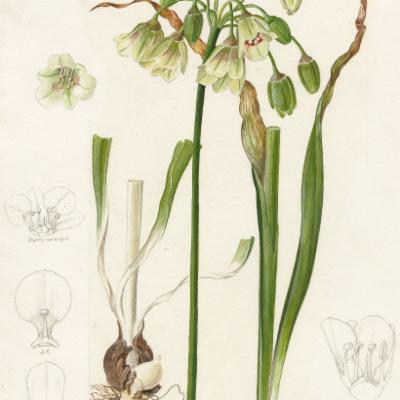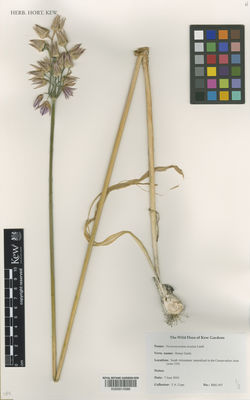-
General Description
-
Sicilian honey garlic has attractive bell-shaped flowers, but don't be fooled by its beauty - like most members of its genus and subfamily it has an unpleasant smell when bruised.
The familiar culinary plants, onions, leeks, garlic and chives, are all members of the genus Allium, which comprises approximately 750 species. Allium siculum is a bulbous plant with narrow leaves and a tall, straight stem with an umbel of hanging, bell-shaped flowers.
The narrow, fleshy leaves of A. siculum emerge in late winter or early spring. The flowering stems appear in May and June, as the leaves die down. The stem emerges from a loose, sheathing leaf, with the flowers enclosed in a pair of green, spathe-like bracts. When this splits, the flowers hang downwards, like small, stiff bells, with glistening nectar inside.
-
Species Profile
-
Geography and distribution
Native to Europe, where it occurs from the Mediterranean to Romania. Allium siculum subsp. siculum occurs from southern France and Corsica to Italy (including Sicily). Allium siculum subsp. dioscoridis is native to eastern Romania, Bulgaria, the Crimea and western Turkey.
Description
Allium siculum is a bulbous plant with narrow leaves 30-40 cm long, and forms an untidy clump at ground level. The leafless flowering stem is up to 120 cm tall, smooth and with a grey colour.
The pendulous flowers are borne in an umbel, each of which contains up to 30 individual flowers. The perianth segments (petals and sepals) are up to 17 mm long, and the inner segments have a single vein. The perianth (petals and sepals) is dull reddish in A. siculum subsp. siculum , and green and pink in A. siculum subsp. dioscoridis .
The fruiting heads are striking, with stiffly upright capsules covered by the papery remains of the perianth. The flattened seeds are 3 mm long.
Threats and conservation
Allium siculum is a widespread species, though never common.
Uses
Allium siculum is grown as an ornamental.
Millennium Seed Bank: Seed storage
The Millennium Seed Bank partnership aims to save plant life worldwide, focusing on plants under threat and those of most use in the future. Seeds are dried, packaged and stored at a sub-zero temperature in Kew's seed bank vault at Wakehurst.
Number of seed collections stored in the Millennium Seed Bank: Two
Cultivation
Allium siculum is easily cultivated in ordinary soil, in sun or light shade. It can produce abundant seeds and become weedy. Its unpleasant smell can be detected at some distance from the plant.
This species at Kew
Allium siculum grows in the Director's Garden at Kew.
-
Distribution
-
Bulgaria, France, Italy, Turkey
-
Ecology
-
Damp woods and fields among rocks.
-
Conservation
-
Not known to be threatened.
-
Hazards
-
Avoided by grazing animals, because of its acrid, garlicky smell and presumably bad taste.



